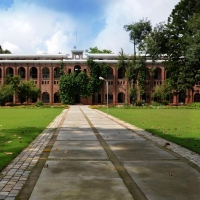The Doon School in Dehradun, Uttarakhand Admission, Fees Structure

Where is The Doon School ?
The Doon School is Located in Dehradun , Uttarakhand, India
Address of The Doon School, Dehradun
Dehradun, India, Pin-248001
Direct Number – +91-135-2526400,
Fax No.(HM Secretariat): +91-135-2757275,
Email: info@doonschool.com
How do I contact The Doon School?
Call at +91-135-2526400 to contact The Doon School
About The Doon School
The Doon School (informally Doon School or Doon) is a boys-only private non-profit, academically selective boarding school in Dehradun, Uttarakhand, India, established in 1935. It was envisioned by Satish Ranjan Das, a Kolkata lawyer, who prevised a school modelled on the British public school, but conscious of Indian ambitions and desires. The school admitted its first pupils on 10 September, 1935, and formally opened on 27 October, 1935, with Lord Willingdon presiding over the ceremony. The school's first headmaster was Arthur E. Foot, an Englishman who had spent nine years as a science master at Eton College, England.
The school houses roughly 500 pupils aged 12 to 18, and admission is based on a competitive entrance examination and an interview with the headmaster. Every year boys are admitted in only two year groups: seventh grade in January and eighth grade in April. As of May 2019, boys from 26 Indian states and 35 non-resident Indians were studying at Doon.The school is fully residential, and boys and most teachers live on campus. In tenth grade, students take the Cambridge IGCSE examinations, and for the final two years can choose between the Indian School Certificate or International Baccalaureate. A broad range of extra-curricular activities, numbering around 80, are offered to the boys, and early masters such as R.L. Holdsworth, J.A.K. Martyn, Jack Gibson and Gurdial Singh established a strong tradition of mountaineering at school. The school occupies the former site of the Forest Research Institute and is home to diverse flora and fauna. Doon remains a boys-only school despite continued pressure from political leaders to become coeducational.Old boys of the school are known as 'Doscos'.
Doon has been consistently ranked the best all-boys residential school in India. Although the school has often been cited as 'Eton of India' by media outlets such as the BBC, The New York Times,The Guardian, The Spectator,The Daily Telegraph, and Washington Post it eschews the label.Doon often draws attention, and sometimes criticism, from the media for the perceived disproportionate influence of its alumni in spheres such as Indian politics, business, or culture. In the 1980s, Prime Minister Rajiv Gandhi's administration was criticised, and labelled "Doon Cabinet", following the appointment of his school acquaintances to major posts. The school has educated a wide range of notable alumni, including politicians, diplomats, artists, writers and businesspeople. Among the former pupils of Doon are the late Indian Prime Minister Rajiv Gandhi, artist Anish Kapoor, novelists Vikram Seth and Amitav Ghosh, fashion designer Tarun Tahiliani, mountaineer Nandu Jayal and social and environmental activists, Bunker Roy and Lalit Pande.
The city is noted for its picturesque landscape and slightly milder climate and provides a gateway to the surrounding region It is well connected and in proximity to Himalayan tourist destinations such as Mussoorie, Dhanaulti, Chakrata, New_Tehri, Uttarkashi, Harsil, Chopta - Tungnath, Auli, India, famous summer and winter trekking destinations like Dodital, Dayara Bugyal, Kedarkantha, Har Ki Dun for camping and grandeur Himalayan panoromic views The Hindu holy cities of Haridwar and Rishikesh along with the Himalayan pilgrimage circuit of Chota Char Dham ie Yamunotri, Gangotri, Kedarnath and Badrinath.
Dehradun is also known for its Basmati rice and bakery products Dehradun is a notable academic and research hub and is home to Indian Military Academy, Rashtriya Indian Military College, Uttarakhand Ayurveda University, Forest Research Institute, Wadia Institute of Himalayan Geology, and Indira Gandhi National Forest Academy According to the combined survey based on health, infrastructure, economy, education and safety; conducted by Dainik Jagran and KPMG, Dehradun is one of the safest cities to live in The city stands at an elevation of approximately 700 metres (2,300 ft) above sea level Also known as the ‘Abode of Drona’, Dehradun has been an important centre for Garhwal rulers which was captured by the British.
Often referred as the gateway to Mussorie Uttarakhand Police is the main law enforcement agency in the city
The winter capital of Uttarakhand is Dehradun, the largest city of the state, which is a rail head Gairsain, a town in Chamoli district is the summer capital of Uttarakhand The High Court of the state is located in Nainital Archaeological evidence supports the existence of humans in the region since prehistoric times The region formed a part of the Uttarakuru Kingdom during the Vedic age of Ancient India.
Among the first major dynasties of Kumaon were the Kunindas in the 2nd century BCE who practised an early form of Shaivism Ashokan edicts at Kalsi show the early presence of Buddhism in this region During the medieval period, the region was consolidated under the Katyuri rulers of Kumaon also known as 'Kurmanchal Kingdom' After the fall of Katyuris, the region was divided into the Kumaon Kingdom and the Garhwal Kingdom In 1816, most of modern Uttarakhand was ceded to the British as part of the Treaty of Sugauli.
Although the erstwhile hill kingdoms of Garhwal and Kumaon were traditional rivals, the proximity of different neighbouring ethnic groups and the inseparable and complementary nature of their geography, economy, culture, language, and traditions created strong bonds between the two regions, which further strengthened during the Uttarakhand movement for statehood in the 1990s The natives of the state are generally called Uttarakhandi, or more specifically either Garhwali or Kumaoni by their region of origin According to the 2011 Census of India, Uttarakhand has a population of 10,086,292, making it the 20th most populous state in India